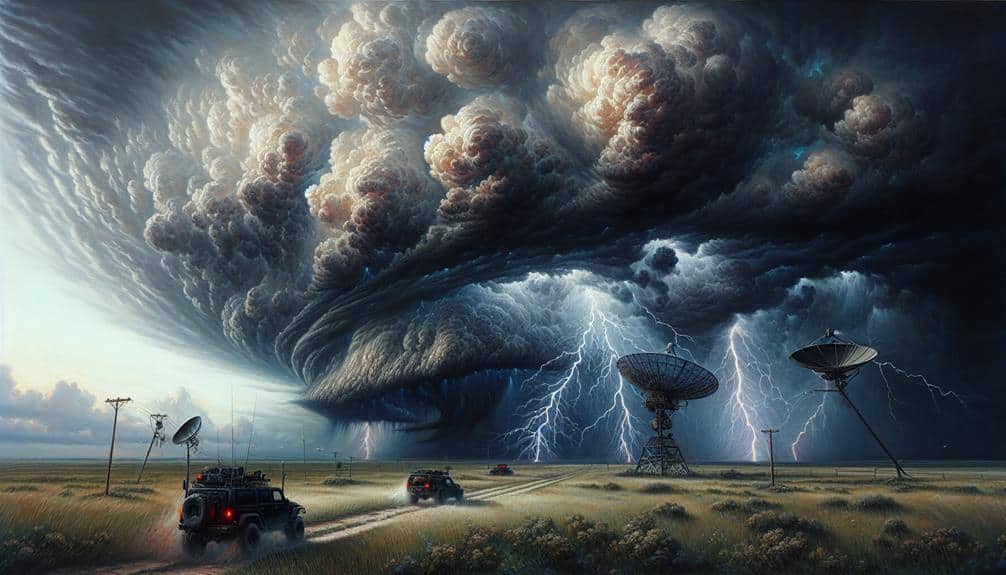Traversing severe thunderstorms safely requires us to comprehend meteorological conditions like unstable air masses and lifting mechanisms. Essential gear includes helmets, waterproof clothing, and reliable flashlights. Real-time weather tracking systems, such as advanced radar and lightning detection, provide critical data on storm intensity. An experienced guide uses this information to avoid hazardous areas and make rapid decisions. We should also have emergency protocols, including designated shelters and evacuation routes. By following these steps, we can enhance safety during severe storms. Continue on to uncover further expert recommendations and protocols.
Key Points
- Choose an experienced guide to assess risks and make informed decisions during severe thunderstorms.
- Utilize real-time weather tracking tools to monitor storm activity and receive timely alerts.
- Wear appropriate safety gear, including helmets, waterproof clothing, and sturdy footwear, to minimize injury risks.
- Keep a NOAA weather radio and a well-stocked emergency kit for real-time updates and essential supplies.
Understanding Severe Storms
To effectively navigate severe thunderstorms, we must first understand the meteorological conditions that define these powerful systems. Severe thunderstorms typically form within unstable atmospheric conditions, characterized by warm, moist air near the surface and cooler, drier air aloft. This creates a conducive environment for the rapid vertical development of cumulonimbus clouds.
Storm formation hinges on three main ingredients: moisture, instability, and a lifting mechanism. Moisture is usually provided by bodies of water or humid air masses. Instability occurs when the temperature decreases rapidly with height, allowing air parcels to rise freely. Lifting mechanisms, such as cold fronts or orographic lift, initiate the upward motion of air, leading to storm development.
Recognizing warning signs is essential for our safety. The presence of dark, towering cumulonimbus clouds, frequent lightning, and rapidly changing wind patterns often precede severe thunderstorms. Additionally, sudden drops in temperature and pressure are indicators of approaching storms.
Technological tools like Doppler radar and satellite imagery also aid in identifying these warning signs early.
Essential Safety Equipment
Equipping ourselves with essential safety gear is important for minimizing risks during severe thunderstorms.
First, let's make sure we've protective gear like helmets and sturdy footwear to safeguard against debris and falling objects. Helmets reduce the risk of head injuries by up to 85%, an important statistic to remember.
Next, rain-resistant clothing is vital to prevent hypothermia. A waterproof jacket and pants with taped seams can keep us dry and maintain our body temperature. Additionally, gloves with high dexterity allow for better grip and control when moving through storm conditions.
A reliable flashlight or headlamp with extra batteries is essential for visibility in low-light situations. These tools can prevent accidents and help us signal for assistance if needed.
Moreover, a NOAA weather radio is necessary for receiving real-time updates and emergency alerts, which are crucial to our safety precautions.
Lastly, carrying a first-aid kit with essentials like bandages, antiseptics, and pain relievers ensures we're prepared for minor injuries. By equipping ourselves with these items, we can effectively mitigate the hazards associated with severe thunderstorms, guaranteeing our freedom to explore safely.
Choosing an Experienced Guide
Selecting a skilled leader with a proven track record greatly enhances our safety and decision-making capabilities during severe thunderstorms. These professionals, often seasoned storm chasers, possess expert knowledge that's indispensable when maneuvering through such volatile environments. Their ability to interpret meteorological data, predict storm behavior, and implement effective safety precautions can make the difference between a close call and a catastrophe.
An experienced guide provides:
- Risk Mitigation: They apply advanced storm analysis to avoid the most hazardous zones.
- Real-Time Decision Making: Their on-the-spot assessments are based on years of firsthand experience.
- Resource Optimization: Guides assure we use our equipment and resources efficiently under stress.
Choosing an experienced guide means we're not just relying on textbook knowledge; we're trusting someone who's faced the fury of nature and come out the other side. Their expert knowledge and safety precautions are key to securing our pursuit of freedom amidst the storm doesn't come at the cost of our well-being.
Without their guidance, we risk making ill-informed decisions that could jeopardize our safety and that of our team.
Real-Time Weather Tracking
Leveraging real-time weather tracking technology allows us to make informed decisions and adapt quickly to changing storm conditions. By employing advanced radar analysis and lightning detection systems, we can accurately monitor storm patterns and movement. This data is essential for storm chasers who thrive on the thrill of the pursuit but also prioritize safety.
Our ability to receive timely weather alerts means we're always a step ahead of severe thunderstorms. These alerts are generated based on up-to-the-minute data from various meteorological instruments, providing us with precise information on storm intensity, trajectory, and potential hazards. Access to this real-time information guarantees we can adjust our plans instantaneously, minimizing risks associated with unpredictable weather phenomena.
Radar analysis enables us to visualize storm structures, identifying key features such as mesocyclones and hail cores. Concurrently, lightning detection systems pinpoint areas with high electrical activity, alerting us to increased storm severity.
Emergency Protocols

Implementing emergency protocols during severe thunderstorms guarantees we can respond swiftly and effectively to any arising dangers. Our first step is to identify and familiarize ourselves with designated emergency shelters in our area. These shelters provide safe havens equipped to withstand severe weather conditions, ensuring our safety.
Next, we need to establish clear evacuation routes. Planning these routes in advance allows us to evacuate efficiently, minimizing panic and confusion. It's essential to have multiple route options in case primary paths are blocked.
To maintain readiness, we should conduct regular drills. These exercises help us internalize our emergency protocols, ensuring everyone knows their roles and responsibilities. Additionally, keeping an emergency kit stocked with essentials like water, non-perishable food, first aid supplies, and flashlights is essential.
To evoke a sense of urgency and preparation, consider the following:
- Safety in Numbers: Knowing our community's emergency shelters creates a network of support.
- Clear Escape Paths: Preplanned evacuation routes reduce chaos and save lives.
- Regular Drills: Practice ensures we're ready when seconds count.
Frequently Asked Questions
How Can I Identify and Avoid Flood-Prone Areas During Severe Thunderstorms?
To identify and avoid flood-prone areas, we analyze flood evacuation maps and urban planning data. This helps us make informed decisions, ensuring our safety during severe thunderstorms while preserving our freedom to navigate effectively.
What Are the Best Apps for Receiving Severe Weather Alerts?
Think of severe weather apps as our digital lifelines. For emergency response and precise weather tracking, we recommend NOAA Weather Radar, AccuWeather, and Weather Underground. They provide real-time alerts, allowing us to act swiftly and stay safe.
How Should I Protect Pets During a Severe Thunderstorm?
We should secure our pets in pet shelters and safeguard our emergency kits include their essentials like food, water, and medications. Precise planning helps protect them during severe thunderstorms, guaranteeing they remain safe and calm.
What Steps Should I Take if My Car Is Caught in a Severe Storm?
Remember when we were trapped in that storm? First, find emergency shelters nearby. Stay inside the car with seatbelts fastened. Call roadside assistance if required. Avoid parking under trees or near power lines to guarantee safety.
Are There Any Specific Dietary Precautions to Consider During Extended Storm Conditions?
We should focus on emergency snacks rich in nutrients and shelf-stable. Hydration strategies are essential; store ample water and electrolyte solutions. Data indicates proper nutrition and hydration maintain energy levels and cognitive function during extended storm conditions.


